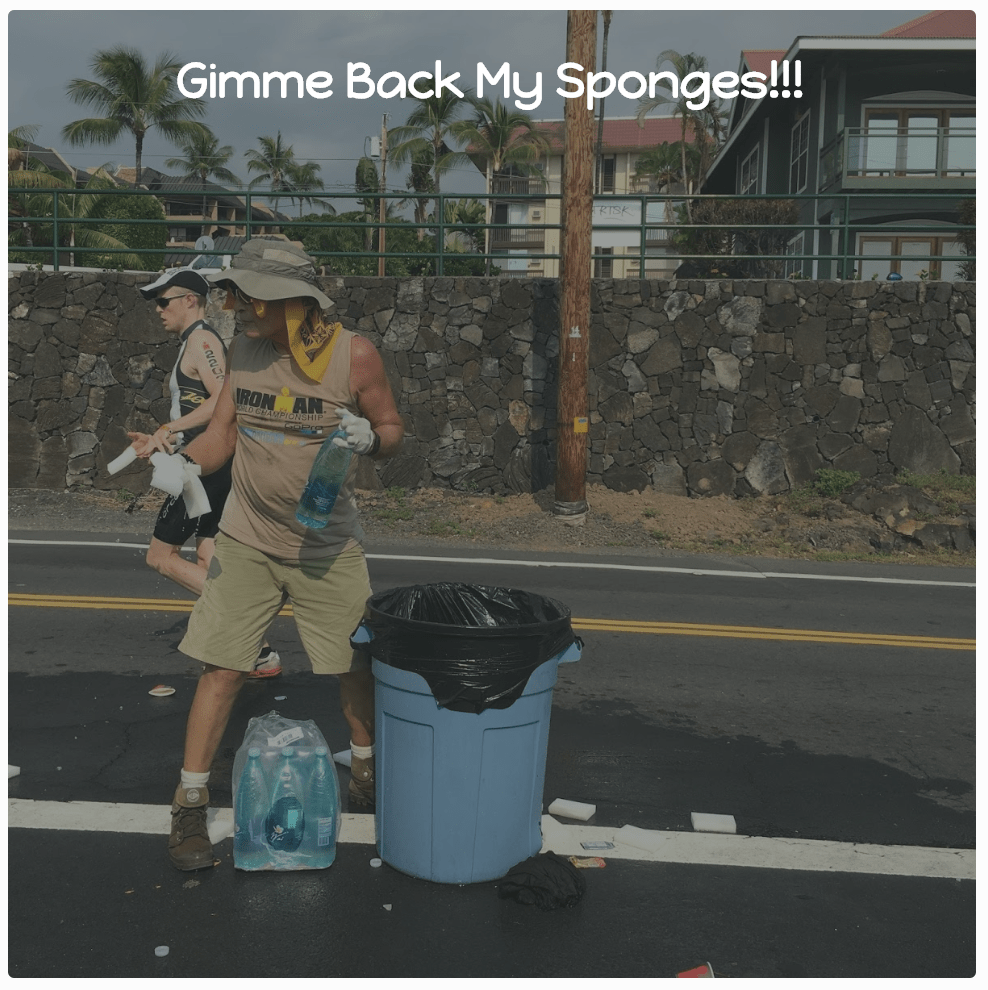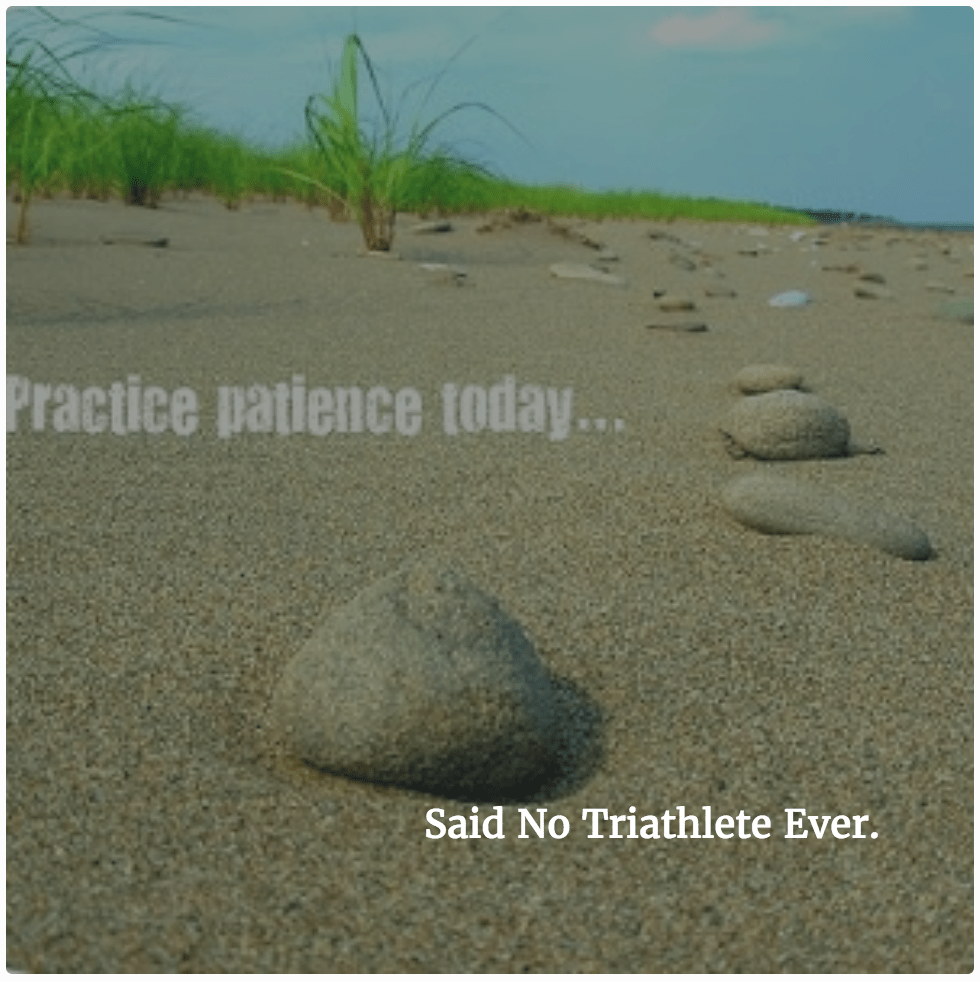
Is it me or does every race seem to be hot these days? Without a doubt, racing in the heat is one of the biggest challenges that endurance athletes face. Staying warm on a cold day isn’t easy, but staying cool under effort is almost impossible. Here is guidance for adjusting your race plan on a hot day.
Racing in the heat is uncomfortable and makes all three disciplines more challenging. But there are several factors that, if unchecked, can make things significantly worse than necessary.
The first thing is your ego.
After months of training and preparing mentally for the big day, it’s hard to adjust your goals because of the forecast. Most competitors will simply attempt to execute their original race plan despite the conditions. This sets them up for dramatic failure and potential health complications!
Next is ignorance.
Not everybody realizes just how bad things can get if you work out too hard in the heat. They are not paying attention to their sweat rate, or lack thereof. They’re not aware of how their core body temperature is increasing dramatically as it accumulates heat. They don’t realize how much fluid they need. Without this awareness, many athletes race themselves into a corner from which they cannot escape.
Finally there is confusion.
It’s easy to become disoriented or on race day when things are falling apart. You have your plan but it’s falling apart because there is no ice left. All the water is warm. Maybe you need fluids and salts much sooner than anticipated.
Having your basic plan disrupted interferes with your ability to make decisions and can really set you back on Race Day. Whether you are ignorant or simply unlucky, if you aren’t in charge of your race, then it’s in charge of your day.
If you aren’t in charge of your race, then it’s in charge of your day.
Step One: Preparing for A Hot Race
The best way to make sure you are ready for race day being too hot is to train for high temperatures. If you line up everything and build experience managing the heat and things don’t get hot, all you have to do is dial them down. If things do you happen to get hot, then you are ready. In other words, the best option is to plan for the worst case scenario.
Your nutrition plan should reflect a hotter race. Doing sweat test is the first step to determining your optimal fluid and calorie combination. Executing that nutrition plan in your regular workouts is critical for a successful race in any conditions.
You can dial things up a bit to anticipate a hot race and set yourself up for success should things start to get too hot. If you require 36 ounces of fluid per hour on a normal day, you might need 48 ounces on a hot day. Or at least, you will probably need 48 ounces in the first hour on the bike.
So practice that 48 ounces per hour in all of your sessions so that you’re ready when the forecast is not in your favor.
You can get accustomed to carrying external salt (in pill form). Try managing your core temperature with water and ice in training. Track the effects of both on your ability to maintain a constant heart rate and excellent pacing. Getting good at handling this challenge additionally will help you increase the odds of your success.
It’s also important to talk about pacing. A well executed race sets you up for success by not placing undue demands on your body.
Everything you eat and drink is used by your body for critical functions. Whether it’s for helping to move your legs or keeping your brain focused, or just helping to operate your basics sympathetic nervous system — every calorie counts. If you ignore your pacing plan and insert strenuous “surges” and lapses of effort things get much harder.
All of a sudden, your aerobic system is working in zone five — attempting to recover — when you’re coasting downhill. This dramatically increases the need for calories and fluids to keep you healthy and moving forward. You can prepare for this scenario by having a race plan with the known targets and practicing it relentlessly in training.
Of all the zones, your heart rate zones is by far the most important. There are other “better” metrics these days with power and pace, but heart rate actually captures the full spectrum of your effort and its effect on your body. Ignore it at your own peril.
Your heart rate should slowly increase as you continue from swim to bike to run, executing your nutrition and pacing plans. You need to know what zones your heart rate “should” be in based upon your training experience. This way you can ensure that you start each leg in the right zone, with room for your heart rate to rise.
In many ways, heart rate is the canary in the coal mine. If you normally see your heart rate at 150 bpm on the run, but in your next race you get off the bike and it’s 165 beats… You have a decision to make. There’s no way you can sustain 15 beats higher for an entire half marathon. Time to dial things back into a safer, sustainable zone.
Power Tip: On hotter race days, most athletes can sustain an increased heart rate between 5 to 8 beats over what they’d normally expect.
Step Two: Refocusing Your Race Day Goals
As an experienced and prepared triathlete, the harder things get on race day the simpler they will be for you. When the heat becomes a factor, race day is no longer about training times or race time goals. It’s no longer about finishing at a certain place or percentage. Heat forces you to focus relentlessly on your process for managing your body, your nutrition, and the variance between what’s normal to be successful on race day.
Unless your ego interferes and forces you to race unwisely, your energy on the bike should be dedicated to how many bottles per hour you’re drinking — not on determining the Age Group of the person who just rode past.
It’s not easy to let go of what you prepared to do, but remember that even in normal conditions most races fall apart at the end of the run. On a hot day that “line” can happen anywhere on race day. You just want to make sure you’re on the right side.
Despite the conditions, the run still remains the most important part of your race. The effects of the heat on the run are much greater than the other two disciplines. Cycling in the heat is not a game-changer because you still have the cool wind blowing on your skin. You have the opportunity to eat and drink without much the digestive cost.
When you’re running, however, your body really feels the heat. Not to mention that it’s also harder to eat and drink on the run. Add tough conditions to a reduced ability to eat and drink…things can go south very quickly. If you stop sweating or become unable to eat and drink, the race is officially over no matter where you are in relation to the finish line.
Step Three: Practicing Patience
The most important thing you can do is to let the race come to you. Any event over five hours is already going to be hard by definition. Once you add in challenging conditions, things start to get complicated.
Looking for a breakthrough performance despite the conditions will only increase the chances of things going wrong for you.
Rather than chasing a performance or the competition, focus on your process and do what you need to do to be successful across the entire day. Never forget that success on race day is defined as not slowing down.
It is also important to remember that early performance on race day has zero correlation to overall race performance. Most hot days start off relatively cool. While the thermometer looks fine, the forecast says otherwise. You know that heat and humidity will be a significant factor – everybody knows it.
But yet, as you begin racing and look around you most people can’t help themselves. They are unable to change their racing effort, they are just getting away with it because it’s still cool. But at some point there’s no denying that the tide will shift on race day.
When that happens, it’s very important that your operating with the mindset towards managing your performance in the conditions. You will need to fight your basic instincts as a triathlete to blindly follow what others are doing if you are going to be successful on a hot day.
Adapting Your Swim
In hot conditions is important to know the true cost of racing in a wetsuit. Temperature guidelines are there for a reason. Even swimming at race effort in the mid-70s in a wetsuit can become problematic. Once you move into the 80s, it’s a liability.
Choosing a wetsuit on a hot day means that you’re shedding significantly more water than normal. It’s not uncommon to see an athlete lose two to four pounds after swim session in a full wetsuit on a hot day. Sure, swimming in a wetsuit will ensure that your time looks good on the clock.
As a competitor you need to ask whether or not you will be able to make up for all the fluids you just lost. While you can’t win the race on the swim, you can absolutely lose it by setting yourself up to race in a dehydrated state.
Choose your swim gear based on your effort level and goals for the day. If you’re attempting to qualify or be at the peak of your Age Group, you may want to choose either a wetsuit with no sleeves, a pair of lava pants (basically a wetsuit from the waist down) or even a swim skin if there are no wetsuits allowed at your event. By reducing the amount of your body that’s covered in neoprene, you are increasing the likelihood that you’ll be better able to regulate your temperature while swimming at race effort.
Being Steady on the Bike
Right out of the gate it’s important to keep your body cool.
The first weapons in your arsenal should be your “stay cool” gear. You want a regular helmet with plenty of venting versus an aero helmet that keeps cooling winds off of your head. You will want arm coolers that you can keep wet and help you stay cool on the bike. You will likely even want an extra cage on your bike just hold water bottles that you can use to pour over your body later in the day as the temperature increases.
Those are the top three, but in addition you’ll want to make sure you have the ability to carry external salt (typically in pill form). You will also want to have backup nutrition available either in special needs or on your bike, just in case you need it.
When you start the bike it’s important that you get your heart rate down your normal long ride zones. If your average long ride has you at 145 beats a minute, you probably start that ride in the first hour between 131 and 135 bpms.
Coming out of transition your heart rate will be seriously elevated on race day — regardless of temperature. Your job in those first couple miles is to get your heart rate down by soft pedaling and coasting is much as possible while you start your nutrition plan. The closer you can get your heart rate down from 155 bpms to 135 bpms, the better your overall race will be.
Fueling becomes more important than pacing in that first hour. Keeping an eye or heart rate is important, but the most critical thing you do in that first hour is begin fueling.
By fueling properly, you are setting the tone for the rest of your day. Remember you cannot consume as many calories as your body requires while it continues to race. Hour One is ten times more important than Hour Two which is 10 times more important than Hour Three…and so on.
Set caps to limit damage on the bike. If you know your target heart rate is 145 bpms, then never let it get above 150 in any conditions unless it’s absolutely necessary to move forward. Same for power. If your target wattage is 165 on race day, never let the watts go higher then 10% more (i.e., 180 watts). This will put your upper limit at about 180 W and will ensure that while you’ll be able to work harder when required, you will be doing significant damage your overall recent performance.
Finally focus on staying cool at the end of the bike. Remember that by the time you get to the end of the bike your body is already experiencing significant stress. And we already know that transitioning to the run will see a dramatic increase your core body temperature. Use that extra cage for a water bottle which you can pour on your body at the last one or two aid stations. This is also the hottest part of the day and so it’s important to be mindful of how the conditions are evolving.
It’s Not Racing, It’s Running (And It’s Really Hot)
Just as we finished the bike by staying cool, you will want to manage the early stations in the run. Be sure to stop at everyone to get soaking wet. We recommend bending over with your legs apart to pour water on your upper body keep your feet dry.
You will also want to eat earlier then what your normal nutrition plan stated. Remember, hotter days mean that your ability to process nutrition will be dramatically reduced over the course of the run.
Setting a time-based plan – a gel every hour – will not be sufficient if your body is operating at a higher level of intensity. This is further complicated by the fact that you be drinking much more than normal whether it’s sports drink, which we recommend, or water. This means that eating earlier is more important. If you feel good, you you should eat.
In the Four Keys of Race Execution, we talk about the importance of taking a walk break at every aid station. On a hot day this becomes mandatory. Walking allows you to get in the right amount of nutrition and to also check in on your present state: How does your stomach feel? How is your sweating? What part of you does not feel so good? What else do you need?
Review all the possible actions can you take to fix your race. Every single a station becomes an opportunity to keep your system consistent rather than ignoring issues that explode into failure.
Remember to keep that actual salt available for when things start to go south. One of the biggest race day complications on a hot day is having an “slushy” stomach. This means that you have a greater deal of fluid then planned in your gut, and the concoction in your stomach has reached a level of “soupiness” which your body can’t process.
Fluid stuck in your gut means that fluids are not getting to the muscles and rest of your body — and that’s a problem. Whatever you do, don’t stop drinking but make sure that you take some salts and reduce your effort to allow your body to process what’s in your stomach. Continue with sports drink and seek out salty beverages if at all possible, such as chicken broth.
The later you get in the day the less you be able to consume. Just a fact. The longer the race the more important alternative nutrition resources such as chicken broth and Coca-Cola become important. These are not necessarily fuel, but by the last hour of your day most of refueling is done. Both of these beverages will help keep you hydrated and settle your stomach while the Coke give you an additional boast boost of caffeine help your mind.
Conclusion
The matter what you do, you can’t ignore the fact that race is going to be hot. How you adjust your plan to fill the day will define your overall performance. Bonus that going through this process will give you a new set of experiences and mental resources to make sure that future races, regardless of the conditions, will be easier to execute.
Turn off the noise, focus on the process, and do your best to slow down less than everyone else. Good luck!






Leave a Reply